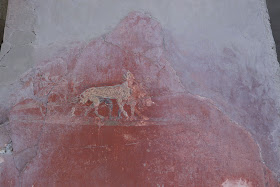Some time during the reign of the Emperor Justinian(527-565 AD), a large cistern was built near the Haggia Sophia, on the site of an old basilica. This was used to store water brought by aqueduct, also built by Justinian, from the Belgrade forest, approximately 19 kilometers away. The water apparently was used mostly by the palace. Other cisterns were also built for water storage in the city.
The cistern was used for water storage for centuries. It was apparently unknown to the Ottomans for about 100 years after they conquered the area(approximately 15th century AD).. It was rediscovered when some people were found to be getting water through holes in their basement floors. It has undergone restoration and was opened to the public in 1987.
According to some historic texts, 7,000 slaves were used in its construction. It is 453 feet long by 212 feet wide. The walls are three and one half meters thick, made of firebrick. The roof is vaulted brick supported by 336 columns, 30 feet tall, arranged in 12 rows of 28 columns in a row. It would hold 2.8 million gallons of water. A special water proof mortar was used. Most, if not all of the columns were recycled from other structures; they are mostly Ionic and Corinthian.
There is only a foot or two of water now present, a walkway has been constructed and lighting put in place.
The photo below is of the cistern looking straight between two rows of columns.
The next photo is shot more diagonally.
The column shown here is quite unique. It is referred to by some as a "peacock eye" column. As far as I know it is not known where it came from.
The next two photos show two Medusa head sculptures used as column base supports. They were brought to the site from an unknown location. Why they were used upside down or sideways is not known. These are the only two Medusas. All the other columns are on regular plain bases.
All in all a very interesting and unique place to visit.
Monday, October 29, 2012
Thursday, October 25, 2012
Naples, Pompeii and Other Sights
Naples is a large(1+ million) city in
southern Italy. A major port, it is a favorite destination for cruise
ships and tourists. Pompeii, Herculaneum, Sorrento and Capri are all
close by. There is a special train called the Circumvesuviana that
runs from its own Naples station to Pompeii and Sorrento. This
station is about a 15 minute taxi ride from the cruise terminal. We
intended to take a taxi(15 euros) to the train(5 euros each) plus
admission fees, then eat at a pizzeria before visiting the
Archaelogical Museum in Naples, which has all the good stuff from
Pompeii. Total cost for transportation only about 31 euros. Each.
We found a taxi driver willing to take
all four of us to the train for 15 euros. We piled in and then the
fun began. “I can take you to Pompeii and pick you up when you are
finished. We can go to Sorrento and I will take you to the Palace and
Opera House in Naples.” “Just the train Station.” “But I can
take you to Pompeii and these other places, too.” Roberta got out
of the Taxi. Cheryl and I said “How about Pompeii, a pizza and the
Archaeological Museum?’’ “I can do that.” “How much?” “25
euros .” “Let’s go!” Roberta got back in and off we went.
The driver’s name was Ciro Palladino.
I would guess he was a man of about 50; he spoke very good English.
When a pedestrian or another vehicle did something he didn’t like
he made a loud noise that sounded exactly like a police whistle. He
would pass buses on the right while we were both making a left turn,
go the wrong way on one way streets, drive down the street car tracks
and commit other acts of terror that fortunately I have suppressed.As we start on our wild ride Ciro
puts a CD in the player and out comes Luciano Pavarotti. Ciro starts
conducting, whistling, driving and occasionally singing along.
Luciano starts singing “Nessun Dorma” and suddenly Uncle Alan,
the Old White Haired Guy, sitting next to Ciro in the front seat,
joins in at full volume. Ciro, both surprised and delighted,
fortunately manages to keep the car on the road.(The OWH is a trained
operatic tenor with an excellent voice). This was followed by more
Luciano, including “Core’ Ingrato”, more OWH, and then some
Neopoliatan songs. There we were, careening down the road with police
whistles, conducting, singing and occasionally driving. Most fun I’ve
had in years.
This photo shows the OWH and Ciro.
He was true to his word-dropped us at Pompeii and was at the meeting
place afterwords at the exact time agreed upon. We then went to the
Archaeological Museum in Naples only to discover it was closed—the
workers were on strike. Fortunately we caught him before he drove off
and we went to a pizzeria. Naples is the birthplace of pizza. We had
an excellent Margherita pizza.
Pompeii was much larger than I had expected. We didn't come close to seeing all of it, but below are some photos.
The three photos above show typical streets. The streets are slightly sunken to allow for water, particular waste water, to flow. The large stones are stepping stones, carefully placed so that a chariot or cart can pass between them.
The top photo above is of a surviving wall painting. The bottom photo shows a mosaic tile floor.
Below is a place of food preparation. The food was stored in the jars built into the counter. Note the wall painting in the background, shown in closeup below.
Below is a plaster cast of some resident of Pompeii, as found during excavation.
The next photo is of a church and square in downtown Naples. Lastly, setting sail into the setting sun.


















